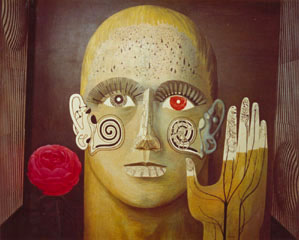Reproduction of her signature:

At school I was always getting A+ for English, and everyone thought this was my thing, but I found myself spending more and more time in the studios, getting very interested in painting, so I went to Croydon Art School, and later to the Royal Collage of Art, and Paris.
Now I both write and illustrate books and do murals, for outside and inside, in paint, plaster, enamels, ceramics, and mosaic.
It is more exciting to alternate painting with writing and designing; one idea can incubate while another is worked out, and that leaves time for a flash of inspiration sometimes.
Some books she wrote and illustrated are;
| Title | Publisher | Year |
|---|---|---|
| The Isle of Wight | King Penguin | 1950 |
| The Unsophisticated Arts | Architectural Press | 1951 |
| Follies and Grottoes | Constable | 1953 |
| English Furniture at a Glance | Architectural Press | 1954 |
| Water Colour Painting | A. & C. Black | 1960 |
| The Gift Book | Max Parrish | 1964 |
| Design for Death | Andre Deutsch | 1967 |
Title: Man's Preceptions.
Date: 1966
Dimensions: height 172 cm, width 178 cm.

The materials used were acrylic resin paints and egg-tempera - powder colours mixed with yolk of egg in this case; the scarlet of the rose is genuine Chinese Vermilion, imported before World War 1.
Here are some of the mechanismes by which we preceive the world around us.
The left eye of the painting in front of you is made up of the structure of the retina, the photoreceptor organ of the eye. The "eyelashes" are the slender rods and the thicker cones of the visual cells; the rods perceive brightness and the cones colour. The incidence of light causes the breakdown of photo-sensitive pigment in the rods and cones, thus initiating electrical impulses (c.f. photo-sensitive cells). More cones work in daylight when there is more colour, more rods as it gets darker. the right eye shows a lower magnification of the middle periphery of the retina surrounding a diagram of the optic nerve.
The shape of the left ear is made of the semi-circular canals which are responsible for our sence of balance, and on the cheekbone is a diagram of the cochlea, where the haire-like cells are receptors for sound, which they transform into nerve-impulses that travel along the acoustic nerve. A vertical section through the cochlea is shown on the right cheekbone.
The node is made of a diagram of part of the olfactory mucous membrane, by which we preceive smells. These are sometimes called as foul, flowery, fruity, resinous, acrid, and spicy - but petrok, for instance, does not fit into any of those categories.
The lower lip is made of a diagram of the taste-buds of the tongue which discriminate between acid, bitter, sweet, and salty substances.
The ability to oppose the thumb and the fingers is enormously important to both man's skill and is perceptions. The diagrams on the hand show, on the thumb, a neverending thought to detect heat or cold; on the first and second fingers, Meissner's corpuscles (tough); on the third finger a Pacinian corpuscle (deep pressure), and on the little finger a nerve plexus thought to signal pain.
On the forehead are shown some of the nerve cells of the cerebral cortex to which these sense organs send their information.
Magnification not to scale.
Reproduction of her signature:

Balcony Perception.